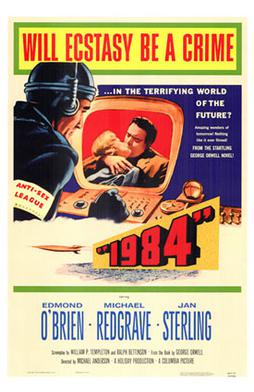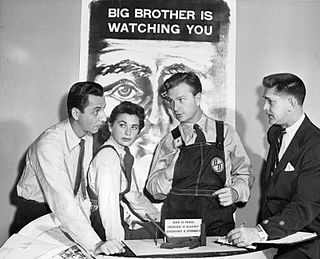
Big Brother is a character and symbol in George Orwell's dystopian 1949 novel Nineteen Eighty-Four. He is ostensibly the leader of Oceania, a totalitarian state wherein the ruling party, Ingsoc, wields total power "for its own sake" over the inhabitants.
In the dystopian novel Nineteen Eighty-Four, thoughtcrime is the offense of thinking in ways not approved by the ruling Ingsoc party. In the official language of Newspeak, the word crimethink describes the intellectual actions of a person who entertains and holds politically unacceptable thoughts; thus the government of The Party controls the speech, the actions, and the thoughts of the citizens of Oceania.
Telescreens are two-way video devices that appear in George Orwell's dystopian 1949 novel Nineteen Eighty-Four. Omnipresent and almost never turned off, they are an unavoidable source of propaganda and tools of surveillance.

2 + 2 = 5 or two plus two equals five is a mathematical falsehood which is used as an example of a simple logical error that is obvious to anyone familiar with basic arithmetic.
The Theory and Practice of Oligarchical Collectivism is a fictional book in George Orwell's dystopian novel Nineteen Eighty-Four. The fictional book was supposedly written by Emmanuel Goldstein, the principal enemy of the state of Oceania's ruling party. The Party portrays Goldstein as a former member of the Inner Party who continually conspired to depose Big Brother and overthrow the government. In the novel, the fictional Goldstein's book is read by the protagonist, Winston Smith, after a supposed friend, O'Brien, provided one copy to him. Winston had recalled that "There were ... whispered stories of a terrible book, a compendium of all the heresies, of which Goldstein was the author, and which circulated clandestinely here and there. It was a book without a title. People referred to it, if at all, simply as The Book."
In the dystopian novel Nineteen Eighty-Four (1949) by George Orwell, the Two Minutes Hate is the daily period during which members of the Outer and Inner Party of Oceania must watch a film depicting Emmanuel Goldstein, the principal enemy of the state, and his followers, the Brotherhood, and loudly voice their hatred for the enemy and then their love for Big Brother.

In the dystopian novel Nineteen Eighty-Four (1949), by George Orwell, the Thought Police are the secret police of the superstate of Oceania, who discover and punish thoughtcrime. Using criminal psychology and omnipresent surveillance the Thinkpol monitor the citizens of Oceania and arrest all those who have committed thoughtcrime in challenge to the status quo authority of the Party and of the régime of Big Brother.
Julia is a fictional character in George Orwell's 1949 dystopian novel Nineteen Eighty-Four. Her last name is not revealed in the novel but she is called Dixon in the 1954 BBC TV production.

1984 is a 1956 British black-and-white science fiction film, based on the 1949 novel Nineteen Eighty-Four by George Orwell, depicting a totalitarian future of a dystopian society. The film was the first feature-length adaptation of the story, and followed a previous Westinghouse Studio One adaptation and a BBC-TV made-for-TV adaptation. 1984 was directed by Michael Anderson and starring Edmond O'Brien as protagonist Winston Smith, and featured Donald Pleasence, Jan Sterling, and Michael Redgrave.
In the dystopian novel Nineteen Eighty-Four (1949), by George Orwell, Hate Week is a psychological operation designed to increase as much as possible the population's hatred of the current enemy of the totalitarian Party, whichever of the two opposing super-states that may be.
References to George Orwell's 1949 dystopian political novel Nineteen Eighty-Four themes, concepts and plot elements are also frequent in other works, particularly popular music and video entertainment.

"1984" is an episode of the American television series Westinghouse Studio One broadcast September 21, 1953, on CBS. Starring Eddie Albert, Norma Crane and Lorne Greene, it was the first adaptation of George Orwell's 1949 novel Nineteen Eighty-Four.

Nineteen Eighty-Four, also known as 1984, is a 1984 dystopian drama film written and directed by Michael Radford, based upon George Orwell's 1949 novel of the same name. Starring John Hurt, Richard Burton, Suzanna Hamilton, and Cyril Cusack, the film follows the life of Winston Smith (Hurt), a low-ranking civil servant in a war-torn London ruled by Oceania, a totalitarian superstate. Smith struggles to maintain his sanity and his grip on reality as the regime's overwhelming power and influence persecutes individualism and individual thinking on both a political and personal level.

In George Orwell's 1949 dystopian novel Nineteen Eighty-Four, the world is divided into three superstates: Oceania, Eurasia and Eastasia, who are all fighting each other in a perpetual war in a disputed area mostly located around the equator. All that Oceania's citizens know about the world is whatever the Party wants them to know, so how the world evolved into the three states is unknown; and it is also unknown to the reader whether they actually exist in the novel's reality, or whether they are a storyline invented by the Party to advance social control. The nations appear to have emerged from nuclear warfare and civil dissolution over 20 years between 1945 and 1965, in a post-war world where totalitarianism becomes the predominant form of ideology, through Neo-Bolshevism, English Socialism, and Obliteration of the Self.

Winston Smith is a fictional character and the protagonist of George Orwell's dystopian 1949 novel Nineteen Eighty-Four. The character was employed by Orwell as an everyman in the setting of the novel, a "central eye ... [the reader] can readily identify with."
Doublethink is a process of indoctrination in which subjects are expected to simultaneously accept two conflicting beliefs as truth, often at odds with their own memory or sense of reality. Doublethink is related to, but differs from, hypocrisy.
In the dystopian novel Nineteen Eighty-Four (1949), by George Orwell, Newspeak is the fictional language of Oceania, a totalitarian superstate. To meet the ideological requirements of Ingsoc in Oceania, the Party created Newspeak, which is a controlled language of simplified grammar and limited vocabulary designed to limit a person's ability for critical thinking. The Newspeak language thus limits the person's ability to articulate and communicate abstract concepts, such as personal identity, self-expression, and free will, which are thoughtcrimes, acts of personal independence that contradict the ideological orthodoxy of Ingsoc collectivism.

Nineteen Eighty-Four is a dystopian novel and cautionary tale by English writer George Orwell. It was published on 8 June 1949 by Secker & Warburg as Orwell's ninth and final book completed in his lifetime. Thematically, it centres on the consequences of totalitarianism, mass surveillance, and repressive regimentation of people and behaviours within society. Orwell, a staunch believer in democratic socialism and member of the anti-Stalinist Left, modelled the Britain under authoritarian socialism in the novel on the Soviet Union in the era of Stalinism and on the very similar practices of both censorship and propaganda in Nazi Germany. More broadly, the novel examines the role of truth and facts within societies and the ways in which they can be manipulated.
O'Brien is a fictional character and the main antagonist in George Orwell's 1949 novel Nineteen Eighty-Four. The protagonist Winston Smith, living in a dystopian society governed by the Party, feels strangely drawn to Inner Party member O'Brien. Orwell never reveals O'Brien's first name. The name indicates that O'Brien is of Irish origin, but this background is never shown to have any significance.
The Ministry of Truth, the Ministry of Peace, the Ministry of Love, and the Ministry of Plenty are the four ministries of the government of Oceania in the 1949 dystopian novel Nineteen Eighty-Four, by George Orwell.
The Ministry of Peace concerns itself with war, the Ministry of Truth with lies, the Ministry of Love with torture and the Ministry of Plenty with starvation. These contradictions are not accidental, nor do they result from ordinary hypocrisy: they are deliberate exercises in doublethink.










